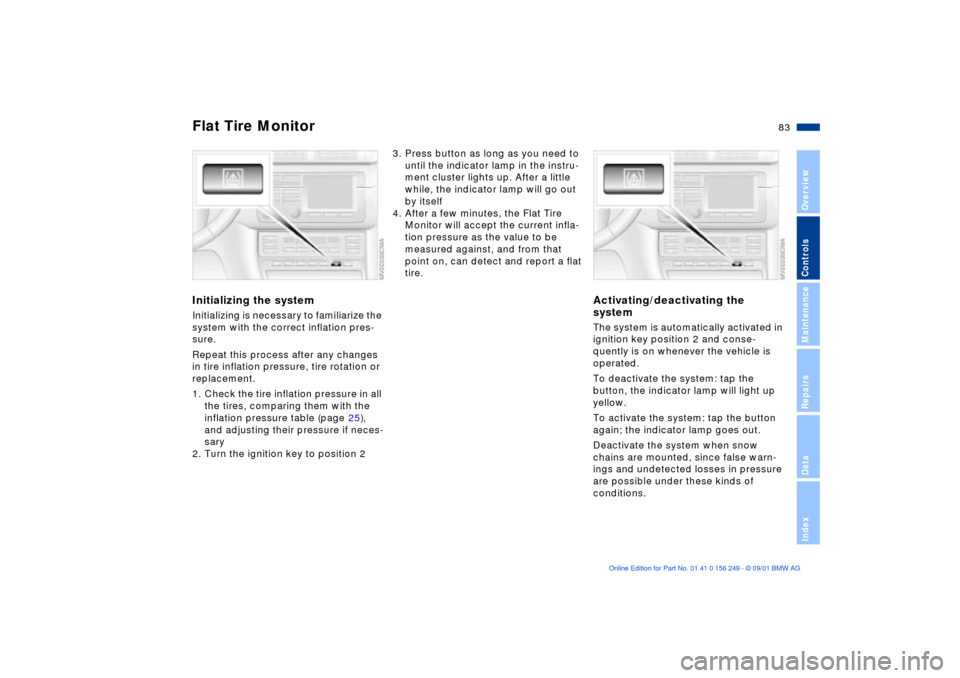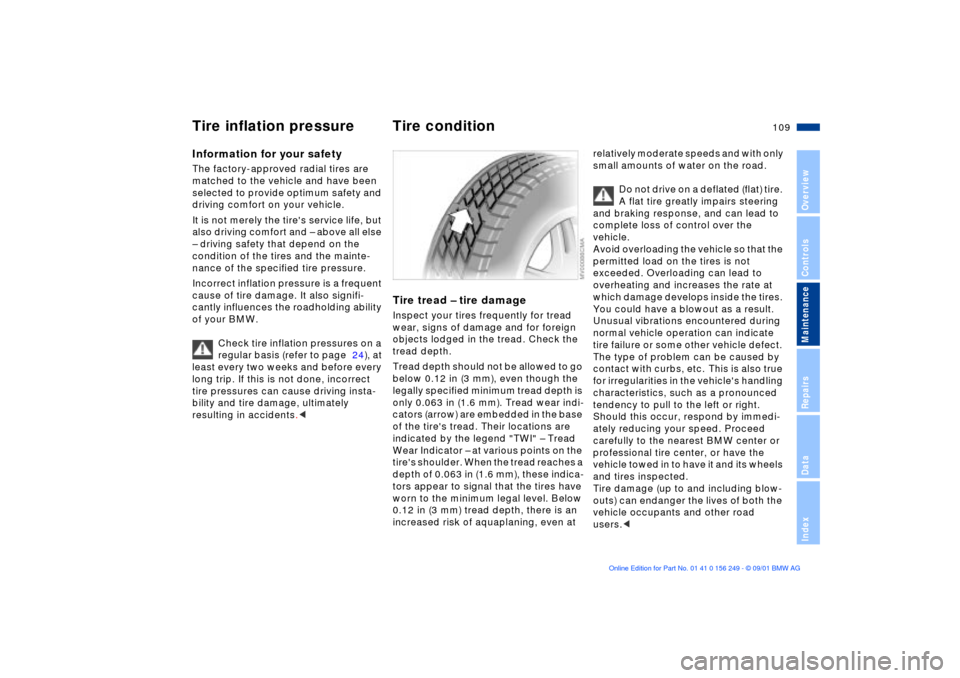tire pressure BMW M3 CONVERTIBLE 2002 E46 Owner's Manual
[x] Cancel search | Manufacturer: BMW, Model Year: 2002, Model line: M3 CONVERTIBLE, Model: BMW M3 CONVERTIBLE 2002 E46Pages: 159, PDF Size: 2.19 MB
Page 4 of 159

Contents
© 2001 BMW M GmbH
Munich, Germany
Reprinting, including excerpts, only with the
written consent of BMW M GmbH, Munich.
Order No. 01 41 0 156 249
US English VIII/01
Printed in Germany
Printed on environmentally friendly paper
(bleached without chlorine, suitable for recycling).
Overview
Controls and features
Cockpit14
Instrument cluster15
Indicator and warning lamps17
Steering wheel with multifunction
buttons21
Warning triangle22
First-aid kit22
Refueling22
Fuel specifications24
Tire inflation pressure24
Opening and closing:
Keys28
Central locking system28
Opening and closing Ð via the
door lock29
lOpening and closing Ð via the
remote control30
Opening and closing Ð from the
inside33
Luggage compartment lid34
Luggage compartment36
Alarm system37
Electric power windows39
Convertible top40
Adjustments:
Correct sitting position44
Seats44
Head restraints46
Entering the rear47
Safety belts48
Seat and mirror memory48
Seat heating49
Steering wheel50
Mirrors50
Passenger safety systems:
Airbags52
Transporting children safely54
Rollover protection system58
Vehicle Memory, Key
Memory60
Driving:
Steering/Ignition lock61
Starting the engine61
Switching off the engine62
Parking brake63
Manual transmission63
Sequential M gearbox SMG II64
Indicator/Headlamp flasher70
Washer/Wiper system/Rain
sensor71
Cruise control73
Everything under control:
Odometer75
Tachometer75
Engine oil temperature gauge75
Fuel gauge76
Temperature gauge76
Service Interval Display76
Check Control77
Clock77
Computer78
Technology for driving comfort
and safety:
Park Distance Control (PDC)80
Dynamic Stability Control
(DSC)81
Flat Tire Monitor82
M Engine dynamics control84
Contents
Page 5 of 159

5n
OverviewControlsMaintenanceRepairsDataIndex
Controls and features
Operation, maintenance
Lamps:
Parking lamps/Low beams85
Instrument lighting86
High beams/Standing lamps86
Fog lamps86
Interior lamps87
Reading lamps87
Controlling the climate for
pleasant driving:
Air conditioner88
Automatic climate control91
Interior conveniences:
Glove compartment95
Storage compartments96
Cellular phone96
Ashtray, front97
Ashtray, rear97
Loading and transporting
cargo:
Ski bag98
Cargo loading100
Roof-mounted luggage rack for
the hardtop101
Special operating instructions:
Break-in procedure104
Driving notes105
Antilock Brake System105
Brake system105
Hardtop106
Wheels and tires:
Tire inflation pressure109
Tire condition109
Tire replacement110
Wheel and tire
combinations111
Winter tires112
Snow chains112
In the engine compartment:
Hood113
Engine compartment
essentials114
Washer fluids115
Engine oil116
Coolant118
Brake fluid119
Maintenance:
The BMW Maintenance
System120
Laws and regulations:
Technical modifications121
California Proposition
65 Warning121
OBD interface socket122
Page 17 of 159

17n
OverviewControlsMaintenanceRepairsDataIndex
Indicator and warning lamps
Technology that monitors itself
Indicator and warning lamps that are
identified by "
l
," are tested for proper
functioning whenever the ignition key is
turned. They each light up once for
different periods of time.
If a fault should occur in one of these
systems, the corresponding lamp does
not go out after the engine is started or
it lights up while the vehicle is moving.
You will see how to react to this below.
Red: stop immediately
Battery charge current
l
The battery is no longer being
charged. There is a malfunction
of the alternator drive belt or in the
charging circuit of the alternator. Please
contact the nearest BMW center.
If the drive belt is defective, do not
continue driving. The engine could
be damaged due to overheating. If the
drive belt is defective, increased
steering effort is also required.
<
Engine oil pressure
l
Stop vehicle immediately and
switch off engine. Check the
engine oil level and top up as required.
Please contact the nearest BMW
center.
Do not continue driving, other-
wise, the engine could be
damaged because of inadequate lubri-
cation.
<
Flat Tire Monitor
l
In addition, an acoustic signal is
sounded: a tire failure has
occurred. To come to an immediate
stop, reduce speed, while avoiding any
sudden, jerky braking or steering
maneuvers.
For additional information: refer to
page 82
Brake warning lamp
l
If the lamp comes on when the
parking brake is not engaged:
check the brake fluid level. Before
driving further, be sure to read the
notes on pages 105 and 119.
Brake warning lamp for Cana-
dian models.
Page 24 of 159

24n
Fuel specifications Tire inflation pressureThe engine uses lead-free gasoline
only.
Required fuel:
>Premium Unleaded Gasoline,
min. 91 AKI.
AKI = Anti Knock Index
Never use leaded fuel, as it would
cause permanent and irreversible
damage to the oxygen sensor and the
catalytic converter.<
Proper inflation pressures are on a
sticker attached to the B-pillar and
visible with the driver's door open.Check tire pressuresAll pressures are specified in the usual
units of the respective country (psi; kilo-
pascal) for tires at ambient temperature
(also refer to the following tire inflation
pressure table).
After correcting the tire inflation pres-
sure, reinitialize the Flat Tire Monitor so
that it can monitor the tire inflation
pressure, refer to page 82.
Check your tire pressures on a
regular basis Ð at least twice a
month Ð and before every extended
journey. Incorrect tire pressure can
otherwise lead to driving instability, tire
damage and accidents.<
Comply with tire approval
specifications The inflation pressures in the table apply
to BMW approved tire sizes and tire
manufacturers. Your BMW center is
familiar with these pressures. Higher
pressures may be specified for tires
made by other manufacturers.
Your vehicle is equipped with tires
which not only meet US standards, but
also European standards. We recom-
mend the exclusive use of BMW
approved tires.
Page 25 of 159

25n
OverviewControlsMaintenanceRepairsDataIndex
Tire inflation pressure BMW Tires
All pressure specifications in
the table are indicated in psi
(kilopascal) with cold tires
(cold = ambient temperature)
225/45 ZR 18 33 (230) - 41 (280) -
255/44 ZR 18 - 35 (240) - 48 (330)
M3 convertible 225/40 ZR 19 33 (230) - 41 (280) -
255/35 ZR 19 - 35 (240) - 48 (330)
225/45 R 17 91 H M+S 33 (230) 38 (260) 36 (250) 46 (320)
Page 82 of 159

82n
Dynamic Stability Control (DSC) Flat Tire MonitorTo deactivate the systemPress the button; the indicator lamp
comes on and stays on.
The vehicle does not execute the
stability-enhancement and traction-
control functions when DSC is deacti-
vated.
We recommend that you deactivate the
system for increased traction:
>when rocking the vehicle or starting
off in deep snow or on loose surfaces
>or when driving with snow chains.
To maintain vehicle stability,
always drive with the system
switched on whenever possible.<
To reactivate the systemPress the button again; the indicator
lamp goes out.Dynamic Brake Control (DBC)DBC is an integral component of the
DSC system.
If you apply the brakes rapidly, this
system automatically generates
maximum braking force boost and thus
helps to achieve the shortest possible
braking distance in "panic braking" situ-
ations. All of the benefits of the ABS
system are exploited under these
circumstances.
Do not reduce the pressure on the
brake pedal for the duration of the
brake application. When the brake
pedal is released, the DBC is deacti-
vated.
The conceptThe Flat Tire Monitor keeps track of the
inflation pressures in your tires as you
drive. The system detects whenever the
inflation pressure in a tire drops off
significantly.
Controlling the tire pressure is based
on monitoring the rpms that the tires
have relative to each other. A flat tire is
detected and reported because the
rpms suddenly deviate drastically from
one another.
Page 83 of 159

83n
OverviewControlsMaintenanceRepairsDataIndex
Flat Tire MonitorInitializing the systemInitializing is necessary to familiarize the
system with the correct inflation pres-
sure.
Repeat this process after any changes
in tire inflation pressure, tire rotation or
replacement.
1. Check the tire inflation pressure in all
the tires, comparing them with the
inflation pressure table (page 25),
and adjusting their pressure if neces-
sary
2. Turn the ignition key to position 2
3. Press button as long as you need to
until the indicator lamp in the instru-
ment cluster lights up. After a little
while, the indicator lamp will go out
by itself
4. After a few minutes, the Flat Tire
Monitor will accept the current infla-
tion pressure as the value to be
measured against, and from that
point on, can detect and report a flat
tire.
Activating/deactivating the
systemThe system is automatically activated in
ignition key position 2 and conse-
quently is on whenever the vehicle is
operated.
To deactivate the system: tap the
button, the indicator lamp will light up
yellow.
To activate the system: tap the button
again; the indicator lamp goes out.
Deactivate the system when snow
chains are mounted, since false warn-
ings and undetected losses in pressure
are possible under these kinds of
conditions.
Page 84 of 159

84n
Flat Tire Monitor
M Engine dynamics control
Flat tire
The indicator lamp in the instru-
ment cluster will light up red in
the event of a flat tire with
ensuing loss in pressure. In addition, an
acoustic signal is sounded. To come to
an immediate stop, reduce speed, while
avoiding any sudden, jerky braking or
steering maneuvers.
Fix the flat tire using the M Mobility
system (refer to page 132).
Resetting the indicator lamp: the red
indicator lamp has to be switched off
manually after putting on a new wheel.
At this point, hold the Flat Tire Monitor
button down until the indicator lamp
goes out. Reinitialize the system after-
ward.
The Flat Tire Monitor cannot alert
you to severe and sudden tire
damage caused by external factors.
Another factor which the Flat Tire
Monitor does not recognize is the
balanced and very gradual pressure
loss that takes place in all tires over an
extended period of time.<
Check the tire inflation pressure
on a regular basis and correct if
necessary, refer to page 24.
Under certain circumstances, there
may be false warnings or a delayed
detection of losses in pressure when
driving on snow-covered or slippery
road surfaces.
Performance-oriented driving (slip at
the drive wheels, high levels of lateral
acceleration) can also delay the
appearance of status reports in the Flat
Tire Monitor's display panel.<
System malfunctionAs long as there is still a malfunction,
the indicator lamp in the instrument
cluster will stay lit up yellow.
Please contact your BMW center for
additional information.
The system (Sport mode identification)
will cause the engine to respond spon-
taneously to the motion of the acceler-
ator pedal. Activating/deactivating
sport-mode identificationActivating: with the key in ignition key
position 2, press the sport button. The
indicator lamp will light up.
The vehicle may gain speed
without any additional pressure on
the accelerator pedal when the system
is activated.<
Deactivating: press the sport button
again; the indicator lamp will go out.
The sport mode is deactivated every
time the engine is started.
Page 105 of 159

105n
OverviewControlsMaintenanceRepairsDataIndex
Brakes: do not rest your foot on
the brake pedal while driving.
Even light but consistent pedal pres-
sure can lead to high temperatures,
brake wear and possibly even brake
failure.
Aquaplaning: when driving on wet or
slushy roads, reduce road speed. If you
do not, a wedge of water can form
between tires and road surface. This
phenomenon is referred to as aqua-
planing, or hydroplaning, and can lead
to partial or complete loss of traction,
vehicle control and braking effective-
ness.
Driving through water: do not drive
through water on the road if it is deeper
than 1 foot (30 cm), and then only at
walking speed. Otherwise the vehicle
can sustain damage to the engine, the
electrical systems and the transmis-
sion.<
The conceptThe Antilock Brake System (ABS) keeps
the wheels from locking while braking,
thereby enhancing active driving safety.Braking with ABSIf you are in a situation that requires full
braking, you will exploit the full benefits
of the ABS system if you apply
maximum brake pressure ("panic
stop"). Since the vehicle maintains
steering responsiveness, you can
nevertheless avoid possible obstacles
with a minimum of steering effort.
Pulsation at the brake pedal combines
with sounds from the hydraulic circuits
to indicate to the driver that ABS is in
its active mode.Cornering Brake Control (CBC)CBC is an advanced engineering
design of the ABS. When braking while
cornering at high speed or braking
during high lateral acceleration, or
when braking during a lane change,
vehicle stability is improved and
steering response is enhanced.
Brake fluid level Low brake fluid level in the reservoir
combined with longer than usual pedal
travel may indicate a defect in one of
the brake system's hydraulic circuits.
Proceed to the nearest BMW
center. Higher brake application
pressure may be necessary when stop-
ping, and the vehicle may exhibit a
slight tendency to pull to one side.
Brake distances may even be longer.
Please remember to adapt your driving
style accordingly.<
Driving notes Antilock Brake System Brake system
Page 109 of 159

109n
OverviewControlsMaintenanceRepairsDataIndex
Information for your safetyThe factory-approved radial tires are
matched to the vehicle and have been
selected to provide optimum safety and
driving comfort on your vehicle.
It is not merely the tire's service life, but
also driving comfort and Ð above all else
Ð driving safety that depend on the
condition of the tires and the mainte-
nance of the specified tire pressure.
Incorrect inflation pressure is a frequent
cause of tire damage. It also signifi-
cantly influences the roadholding ability
of your BMW.
Check tire inflation pressures on a
regular basis (refer to page 24), at
least every two weeks and before every
long trip. If this is not done, incorrect
tire pressures can cause driving insta-
bility and tire damage, ultimately
resulting in accidents.<
Tire tread Ð tire damageInspect your tires frequently for tread
wear, signs of damage and for foreign
objects lodged in the tread. Check the
tread depth.
Tread depth should not be allowed to go
below 0.12 in (3 mm), even though the
legally specified minimum tread depth is
only 0.063 in (1.6 mm). Tread wear indi-
cators (arrow) are embedded in the base
of the tire's tread. Their locations are
indicated by the legend "TWI" Ð Tread
Wear Indicator Ð at various points on the
tire's shoulder. When the tread reaches a
depth of 0.063 in (1.6 mm), these indica-
tors appear to signal that the tires have
worn to the minimum legal level. Below
0.12 in (3 mm) tread depth, there is an
increased risk of aquaplaning, even at
relatively moderate speeds and with only
small amounts of water on the road.
Do not drive on a deflated (flat) tire.
A flat tire greatly impairs steering
and braking response, and can lead to
complete loss of control over the
vehicle.
Avoid overloading the vehicle so that the
permitted load on the tires is not
exceeded. Overloading can lead to
overheating and increases the rate at
which damage develops inside the tires.
You could have a blowout as a result.
Unusual vibrations encountered during
normal vehicle operation can indicate
tire failure or some other vehicle defect.
The type of problem can be caused by
contact with curbs, etc. This is also true
for irregularities in the vehicle's handling
characteristics, such as a pronounced
tendency to pull to the left or right.
Should this occur, respond by immedi-
ately reducing your speed. Proceed
carefully to the nearest BMW center or
professional tire center, or have the
vehicle towed in to have it and its wheels
and tires inspected.
Tire damage (up to and including blow-
outs) can endanger the lives of both the
vehicle occupants and other road
users.<
Tire inflation pressure Tire condition